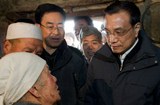Supporting scientific and technological, educational, cultural and health undertakings. From 2011 to 2012, military academies, research institutions and specialized technical units undertook more than 200 research subjects including national major projects and key technology R&D programs; participated in 220 projects tackling key scientific and technological problems; and transferred 180 technologies. A total of 108 PLA and PAPF hospitals have paired up with 130 county-level hospitals in poverty-stricken areas in the western parts of the country, while medical and health units below the corps level have paired up with 1,283 clinics and health centers in towns and townships. From 2009 to 2012, the armed forces financed and built 57 "August 1" schools particularly in areas inhabited by ethnic minorities in the western parts of the country, such as Xinjiang and Tibet, providing schooling for over 30,000 children.
Participating in Emergency Rescue and Disaster Relief
China is one of the countries most vulnerable to natural disasters. With more varieties, wide distribution and high frequency, natural disasters endanger China's economic and social development as well as the lives and property of many Chinese people. The armed forces of China have always acted as the shock force in emergency rescue and disaster relief, and always undertaken the most urgent, arduous and hazardous rescue tasks. According to the Regulations on the PLA's Participation in Disaster Rescue promulgated in 2005, the PLA and PAPF are mainly tasked with rescuing and evacuating the trapped; ensuring the security of important facilities and areas; salvaging and transporting important materials; participating in specialized operations such as rush repairs of roads, bridges and tunnels, maritime search and rescue, NBC rescue, epidemic control, and medical aid; eliminating or controlling other major dangers and disasters; and assisting local governments in post-disaster reconstruction.
The PLA, PAPF and people's governments at various levels have established military-civilian joint response mechanisms for natural disasters, set up a mobile command platform for emergency response at the strategic level, pre-stored and pre-positioned in key areas materials and equipment urgently needed for emergency rescue and disaster relief, worked out relevant scenarios for units at and above the regiment level, and organized joint military-civilian exercises and training, thereby enhancing their capabilities for emergency rescue and disaster relief in all respects. So far, China has formed nine state-level professional teams, with a total membership of 50,000. They are emergency-response teams for flood relief, earthquake rescue, NBC defense, emergency airlift, rush repair of transportation and power facilities, maritime search and rescue, mobile communications support, medical aid and epidemic prevention, and meteorological support. In collaboration with relevant provinces (autonomous regions, and municipalities directly under the central government) and based on active and reserve forces, all MACs have joined to set up professional emergency-rescue units at the provincial level, totaling 45,000 members.
In all major emergency-rescue and disaster-relief operations, China's armed forces have always played a vital role. In 2008, some 1.26 million officers and men as well as militia members were sent to counter the disaster of freezing weather, sleet and snowstorms in southern China, and 221,000 to participate in rescue after the devastating earthquake in Wenchuan County, Sichuan Province. In 2010, some 21,000 and 12,000 armed forces members were dispatched respectively to take part in rescue after the Yushu (Qinghai Province) earthquake and the Zhouqu (Gansu Province) mud-rock slide. Since 2011, the PLA and PAPF have contributed a total of 370,000 servicepersons and 197,000 vehicles or other machines of various types, flown over 225 sorties (using fixed-wing aircraft and helicopters), organized 870,000 militiamen and reservists, participated in emergency-rescue and disaster-relief operations in cases of floods, earthquakes, droughts, ice jams, typhoons and fires, rescued or evacuated more than 2.45 million people, and rushed 160,000 tons of goods to disaster areas. Every year, the army aviation flies hundreds of sorties to prevent and fight forest and grassland fires on a regular basis.
Maintaining Social Stability
In accordance with relevant laws and regulations, the armed forces of China participate in social order maintenance, and guard and fight against terrorist activities. The PAPF is the state's backbone and shock force in handling public emergencies and maintaining social stability. The Law of the People's Republic of China on the People's Armed Police Force, promulgated in August 2009, specifies the scope, measures and support of PAPF security missions. With mobile PAPF troops as the mainstay, supplemented by forces pooled from routine duty units, and supported by various police forces and PAPF academies, the PAPF has established a force structure for stability maintenance and emergency response. In addition, a counter-terrorism force structure has been set up, which consists of a counter-terrorism contingent, special-duty squadrons, special-duty platoons and emergency-response squads at state, province, municipality and county levels, respectively. Solid steps have been taken to implement strict security measures for major events, including guard duties, security checks, security of important facilities and areas, checkpoints on major roads, and armed urban patrols. From 2011 to 2012, the PAPF effectively responded to and handled various emergencies, coordinated with public security organs to successfully handle some violent and terrorist attacks, and participated in handling 68 incidents of serious violence, and rescuing 62 hostages. Altogether contributing more than 1.6 million persons, the PAPF has provided security for such important events as the 26th Summer Universiade (Shenzhen, 2011), China-Eurasia Expo (Urumqi, 2011) and Shanghai Cooperation Organization (SCO) Beijing Summit (2012).
 |  |

 分享到人人
分享到人人 分享到QQ空间
分享到QQ空间














 回访和习近平握手渔民
回访和习近平握手渔民















